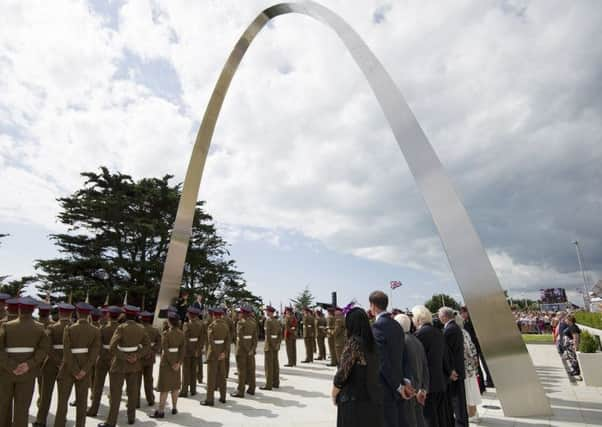Nation united in remembrance of those who served


In Folkestone, Prince Harry joined thousands to commemorate the men and women who travelled to and from the Western Front during the First World War.
The prince, who wore No1 dress of the Blues and Royals, greeted dignitaries before unveiling Folkestone’s memorial arch and laying a wreath at the town’s war memorial.
Advertisement
Hide AdAdvertisement
Hide AdTwo buglers from the Tower of London played The Last Post and the prince took the salute of a military and civilian parade before walking along the Road of Remembrance to Folkestone’s harbour.
He watched as 600 white balloons bearing the names of each person listed on Folkestone’s war memorial were released.
A Kensington Palace spokesman later said: “Folkestone played an integral part in the Great War as the port of embarkation and return, to and from, the Western Front for millions of men and women.”
He added: “For many it was their last time on British soil before heading to the battlefields of France and Belgium.”
In Belfast, Prince Andrew, the Duke of York, a helicopter pilot in the Falklands conflict, read a lesson and lit a candle during a service.
The Archbishop of Armagh Dr Richard Clarke said commemoration of the First World War could not be spiritually separated from carnage in Gaza and other contemporary trouble spots.
He said: “War must always represent the abject failure of the human spirit and of humanity itself.
“It can never be other and we should never pretend it is other.”
Advertisement
Hide AdAdvertisement
Hide AdNorthern Ireland Secretary Theresa Villiers, the province’s First Minister, Peter Robinson, and Irish heritage minister Heather Humphreys were among those attending the service at the Church of Ireland’s St Anne’s Cathedral in the city centre.
Young people lit five candles, each representing a year of the war. The Royal British Legion raised two standards and an act of remembrance was introduced by Dean of Belfast John Mann.
Dr Clarke said: “Without being guilty of the worst kind of religious escapism, we cannot spiritually separate the violence, the carnage and the suffering of the innocent that is under our gaze today – whether in Gaza, in Israel, in Syria, in Ukraine or in Iraq – from our memorialising of the beginnings of the First World War.”
At Grey Point Fort in Co Down, part of a network of coastal defences which guarded the mouth of Belfast Lough during the First World War, a Vickers 6in gun was fired to commemorate Britain’s declaration of hostilities against Germany.
It was decommissioned in 1956 and has been managed as a historical monument, one of several examples of defence heritage across the country.
It is estimated that more than 200,000 Irish-born soldiers served in the British Army and Royal Navy from 1914 to 1918.
Many of the commemorative events began late in the evening to coincide with the hour Britain declared war on Germany in 1914.
In Wales, a national service of remembrance took place at Llandaff Cathedral in Cardiff marking the start of four years of events in Wales.
Advertisement
Hide AdAdvertisement
Hide AdThe country’s First Minister Carwyn Jones attended the service, along with the Duke and Duchess of Gloucester. Archbishop of Wales, Dr Barry Morgan, led the service.
At Westminster Abbey, the flame of a single oil lamp at the tomb of The Unknown Warrior was extinguished at 11pm – marking the finale of a televised candlelit vigil there, which saw more than 1,000 candles held by the congregation slowly extinguished. The abbey service also featured 1914 poetry recitals, and the performance of Ralph Vaughan Williams’ The Lark Ascending, written in 1914.